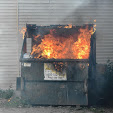This led to an interesting offshoot in the evolution of SLRs: Simple, practically point-and-shoot, SLRs marketed to beginners. While modern DSLR cameras certainly can be, and are
The Nikon EM, introduced in 1979, was a departure from traditional Nikon SLRs, which had been tank-like, all-metal things. The EM was smaller, lighter, and less expensive than usual, containing a large amount of plastic in its construction. The body's lines were sculpted by Italian industrial designer Giorgetto Giugiaro, better known for the Lotus Esprit, BMW M1, and DeLorean. Internally, it was conceptualized as an "SLR camera for women".
The top of the camera, instead of the usual array of knobs, had a dial for setting the film speed and a simple selector for auto exposure, a manual 1/90th second exposure (the flash synch speed, but would also work in case the batteries went tango uniform) and Bulb, for using a cable release.
The shooter still had to dial in the aperture, but the camera would pick the shutter speed, and beep politely to let you know if the required exposure time would be 1/30th of a second or longer, which could cause blur from camera motion. The camera used the entire array of standard Nikon "F-mount" lenses, thus serving as a gateway drug to further Nikon purchases.
In 1983, Canon released the T50. This camera goes several steps further than the EM in the easy-to-use department. For starters, it has a built-in motor drive, so film loading and advancing is automated, but you still have to rewind manually at the end of the roll.
The T50 uses Program mode for all shooting: Set the aperture ring on the lens to "A" and the camera handles all the aperture and shutter speed chores. All you have to do is drop the film in and manually set the ISO, focus, and watch out for the blinking "P" in the viewfinder, which lets you know if a shot is no bueno.
These cameras are generally available for a song
Minolta's Maxxum 3000i, released in 1988, is entirely automated. Drop the film in and it loads itself, reads the DX code on the canister to set film speed and is ready to go. It's an autofocus and the lens mount is still in use as the Sony "α" mount. If the Nikon EM was a synchromesh manual gearbox and the Canon T50 was a paddle-shifted twin-clutch manual, this is an actual automatic transmission.

The top of the camera is practically devoid of controls. There's an off-on switch, a button for the self-timer, and a button that selects "Hi Speed" mode, which is basically a shutter-priority mode that selects the fastest shutter speed to stop action.
All in all, it's about the least-intimidating film SLR I'm ever seen. No wonder this Lomographer loved it; it fits in with the Lomo "just shoot" ethos perfectly.
.





